Advisory on Union Officer Elections and Public Disclosure Reporting in Areas Affected by the Coronavirus (COVID-19)
 Due to the Coronavirus (COVID-19), the Department of Labor’s Office of Labor-Management Standards (OLMS) issues this advisory regarding the labor union officer election requirements under Title IV and the reporting requirements of Title II of the Labor-Management Reporting and Disclosure Act of 1959 (LMRDA). OLMS recognizes that due to the disruption caused by COVID-19, it may be difficult or impossible for some unions to conduct timely union officer elections. Similar difficulties may confront unions, labor relations consultants, and employers faced with public disclosure filing requirements. OLMS issues this advisory for those unions, employers, or labor relations consultants affected by COVID-19.
Due to the Coronavirus (COVID-19), the Department of Labor’s Office of Labor-Management Standards (OLMS) issues this advisory regarding the labor union officer election requirements under Title IV and the reporting requirements of Title II of the Labor-Management Reporting and Disclosure Act of 1959 (LMRDA). OLMS recognizes that due to the disruption caused by COVID-19, it may be difficult or impossible for some unions to conduct timely union officer elections. Similar difficulties may confront unions, labor relations consultants, and employers faced with public disclosure filing requirements. OLMS issues this advisory for those unions, employers, or labor relations consultants affected by COVID-19.
Elections: The LMRDA requires that all national and international labor unions elect their officers not less often than every five years. Officers of intermediate bodies, such as general committees, system boards, joint boards, joint councils, conferences, and certain districts, district councils and similar organizations, must be elected at least every four years, and officers of local labor unions not less often than every three years. See the OLMS Electing Union Officers publication for further information.
Labor unions affected by COVID-19 must still make a good faith effort to conduct officer elections within LMRDA timeframes. OLMS has jurisdiction to file a civil enforcement action concerning a failure to hold a timely election after receipt of a complaint from a union member who has first sought a remedy from his or her union. If OLMS receives a complaint from a union member solely regarding a union’s failure to hold an election within the LMRDA timeframes, but the election has been completed prior to OLMS receipt of the complaint, then OLMS will take no enforcement action. If OLMS receives a complaint regarding a union’s ongoing failure to hold an election, and that failure was attributable to COVID-19, OLMS will promptly seek a voluntary compliance agreement with the union. The agreement would require the union to hold the election when practicable on a date certain. With such an agreement, OLMS will not seek a civil enforcement action based on the complaint, provided the election is held in conformance with the agreement.
Public Disclosure Reports (LM reports): Labor unions, labor relations consultants, and employers affected by COVID-19 must make a good faith effort to file required public disclosure reports. The failure to file a timely and complete report is an ongoing violation of the LMRDA. OLMS has jurisdiction to file a civil enforcement action concerning a failure to meet reporting requirements. OLMS will not, however, pursue a civil enforcement action with regard to a delinquent or deficient report when these reporting violations are attributable to COVID-19. Unions, employers, and labor relations consultants wishing to take advantage of this enforcement policy should contact OLMS before the report is due, describe the circumstances necessitating additional time, and provide a date certain by which the report can reasonably be submitted. Under these circumstances, OLMS will not lodge a civil enforcement action to obtain the delinquent or deficient report. Unless an extension is granted, LM reports are due by March 31, 2020.
Tag: DOL
BNSF Railway to pay more than $147K in back wages, damages to former employee

OSHA has ordered BNSF to pay more than $147,000 in back wages and damages and take other corrective actions. Agency investigators determined the company retaliated against the former employee in violation of the Federal Railroad Safety Act. A Berkshire Hathaway company, BNSF is an international railroad operator headquartered in Fort Worth, Texas. It employs more than 42,000 employees.
“BNSF employees have the right to protect their safety and that of other employees and the public without fear of retaliation by their employer,” said Gregory Baxter, regional OSHA administrator in Denver. “Our investigation and our actions on this worker’s behalf underscores the agency’s commitment to take vigorous action to protect workers’ rights.”
The company and the former employee may file objections or request a hearing, within 30 days of receipt of the agency’s order, before the department’s Office of Administrative Law Judges.
OSHA enforces the whistleblower provisions of the CPSIA and 21 other statutes protecting employees who report violations of various airline, consumer product, environmental, financial reform, food safety, health care reform, nuclear, pipeline, public transportation agency, railroad, maritime and securities laws.
Employees who believe that they have been retaliated against for engaging in protected conduct may file a complaint with the secretary of labor. More information is available online at http://www.whistleblowers.gov/index.html.
The GOP has announced that it will fight a Department of Labor (DOL) rule requiring employers to report having hired third parties to draft and deliver anti-union messages to workers. The measure was announced by the DOL in the Federal Register March 24 and went into effect last week. The rule applies to all agreements and arrangements beginning on or after July 1. Representative Phil Roe (R-Tenn.) called for the elimination of the rule in a hearing Tuesday, April 26. Rep. Jared Polis (D-Colo.) said in his opening remarks that “working men and women deserve to know who their employer is hiring and how much the employer is spending to discourage them from joining a union.” Read more from Truthout. Click here to read about the DOL rule.

News Release
WASHINGTON – Many characterize union organizing campaigns as debates between management and labor over the impact of unionization on businesses and workers. Today, employers commonly engage third-party consultants in crafting and delivering anti-union messages to workers. Workers often do not know when employers engage consultants behind the scenes to influence their decisions. To address this lack of transparency, a new rule from the U.S. Department of Labor will require reporting of employer-consultant, or “persuader” agreements – to complement the information that unions already report on their organizing expenditures, resulting in better information for workers making decisions on whether or not to form a union or bargain collectively. “Workers should know who is behind an anti-union message. It’s a matter of basic fairness,” said U.S. Secretary of Labor Thomas E. Perez. “This new rule will allow workers to know whether the messages they’re hearing are coming directly from their employer or from a paid, third-party consultant. Full disclosure of persuader agreements gives workers the information they need to make informed choices about how they pursue their rights to organize and bargain collectively. As in all elections, more information means better decisions.” “This rule is about disclosure, and more disclosure here means more peaceful and stable labor-management relations. With workers having a better understanding of the true source of persuader communications, worker-supervisor and other workplace relationships are likely to proceed more smoothly no matter what is decided regarding union representation,” said Office of Labor-Management Standards Director Michael Hayes. The new rule interprets Section 203 of the Labor Management Reporting and Disclosure Act. The law requires labor organizations, consultants, and employers to file reports and disclose expenditures on labor-management activities. The law intends to prevent abuse, corruption, and improper practices by labor organizations, employers, and labor relations consultants alike. A longstanding loophole, however, allows employers to hire consultants to create materials, strategies and policies for organizing campaigns – and even to script managers’ communications with employees – without disclosing anything, as long as the consultant does not directly contact employees. The new rule closes the loophole to align the regulation with the statute, by requiring reporting on “actions, conduct or communications that are undertaken with an object, explicitly or implicitly, directly or indirectly, to affect an employee’s decisions regarding his or her representation or collective bargaining rights.” Under the same statute, unions already are required to make comprehensive public reports on their expenditures, including expenditures on union-organizing campaigns. The Federal Register will publish the new rule on March 24. The change will be applicable to arrangements, agreements, and payments made on or after July 1, 2016. The final rule and additional information is available on the OLMS website at http://www.dol.gov/olms/regs/compliance/ecr_finalrule.htm.

“With today’s Bureau of Labor Statistics’ report, we are reminded again that the labor movement continues to be one of the most powerful forces for strengthening the middle class and providing economic stability, for members and non-members alike.
“Median weekly earnings of full-time union workers ($975) were more than 25 percent higher than those of non-union workers ($776) in 2015. That’s not pocket change – it comes to more than $10,000 per year. That goes a long way toward writing the mortgage check, paying down the car loan, or even just keeping the kids in snow boots. And, that doesn’t even account for the superior benefits, safer workplaces and other advantages that come with union representation.

“Plus, strong unions empower all working people, putting upward pressure on wages and labor standards throughout the economy. After all, you don’t need a union card to have benefitted from the advent of the weekend.
“So we all have skin in the game when unions are threatened and collective bargaining rights come under attack. When a larger percentage of workers belong to unions, the middle class grows and thrives. But research shows that a decline in union membership over roughly the last four decades is responsible for one-third of the growth in wage inequality among men and one-fifth of the growth in wage inequality among women.
“The Obama administration continues to push back against these attacks, exploring avenues for strengthening the right to organize and new strategies for giving workers greater voice on the job. We believe this essential to building an economy that works for everyone.
“We’ve made a dramatic turnaround in the last seven years – from a devastating recession to the highest levels of job growth since the late 1990s. But, there is still unfinished business. We must do more to ensure that all working families can share in the fruits of this recovery.
“When more workers are able to stand together and speak up for one another, negotiating for their fair share of the value they help create, it strengthens all of us. To restore balance to the economy and create shared prosperity, we need robust labor unions and powerful worker voice.”
Data indicates that transportation industry growth will add 417,000 skilled and semi-skilled job openings from 2012 to 2022.

“Careers in the transportation industry can lift Americans into the middle class or help them stay there, and this report concludes that there will be more job opportunities in the near future,” said U.S. Secretary of Transportation Anthony Foxx. “We want to fill all these new positions, so industry and government must increase recruitment and help young people get the skills, training, and apprenticeships they need to gain entry into these careers.”
The report indicates that employers will need to hire and train a total of 4.6 million new workers – 1.2 times the current transportation workforce – due
Much of the regional transportation job growth is driven by growth in the large metropolitan areas within those regions – the highest number of job openings in transportation will likely be generated in New York City, Dallas, Los Angeles, Houston, and Chicago. In addition, these jobs will pay relatively well. Thirteen out of the top 20 highest demand transportation jobs pay above the median wage, sometimes substantially.
“Ensuring that America continues to lead the way in the global economy means not only investing in the physical infrastructure that allows us to move goods and keep up with global demand, but also the skills infrastructure to support this growing workforce,” said U.S. Secretary of Labor Thomas E. Perez. “Through smart investments in apprenticeships and other work-based training programs, transportation jobs are helping millions of Americans punch their tickets to the middle class.”

But the report also highlights a significant skills gap in the demand for and supply of high skilled workers; it indicates that projected annual job openings are 68 percent larger than the number of students who are completing related educational programs annually across selected transportation occupational groups. One solution is an increase in Career and Technical Education programs of study. Such programs begin in high school and continue into postsecondary education or apprenticeship and provide the foundational and early occupational skills training needed in skilled occupations. Pre-apprenticeship programs for disadvantaged youth and adults can prepare low-skilled and underrepresented populations for entry into these skilled positions. Furthermore, Career Pathways systems that are aligned with Registered Apprenticeship programs can expand the number of people who can access these high-demand jobs.
“In today’s society, it is important that all of our students are well-equipped with the knowledge and skills to compete in a global economy,” said U.S. Secretary of Education Arne Duncan. “There are incredible opportunities for Americans in the transportation industry and the Department is fully committed to working with leaders in the industry to promote partnerships between education and workforce institutions in order to support training programs that will help our country succeed.”
Read the full report here.

The 15-member council provides advice on policies and regulations affecting employee benefit plans governed by the Employee Retirement Income Security Act. The secretary of labor appoints members for staggered 3-year terms. Members represent specified groups or fields that are involved in employee benefits.
The council meets at least four times a year and makes recommendations to the secretary regarding functions carried out under ERISA. Participation in the council’s meetings and other work generally requires a commitment of 15 to 20 days per year.
EBSA will accept nominations to fill one vacancy in each of the following five fields:
- Employee organizations
- Employers
- Investment counseling
- Actuarial counseling
- The general public
Interested individuals and organizations may nominate qualified candidates for membership.
Nominations should briefly describe the individual’s qualifications, and the group or field the candidate represents. Nominations should also include the nominee’s full name, work affiliation, mailing address, phone number and email address. The nomination should also state that, if offered, the candidate would accept the appointment to the ERISA council. Nominations must be submitted by letter, resolution or petition, and be signed by the person or, in the case of a nomination by an organization, by the group’s representative making the recommendation. Additionally, each nomination must include the nominating party’s full name, mailing address, phone number and email address.
Send nominations either by mail or email. Address mailed nominations to Larry Good, Executive Secretary, ERISA Advisory Council, Room N-5623, U.S. Department of Labor, 200 Constitution Ave. NW, Washington, D.C. 20210. Alternatively, send nominations by email to good.larry@dol.gov. The nomination must be a separate attachment to the email.
To read the Federal Register Notice, visit https://federalregister.gov/a/2015-14781. Additional information about the council and the appointment process can be found on EBSA’s website at http://www.dol.gov/ebsa/aboutebsa/erisa_advisory_council.html.

The department’s Occupational Safety and Health Administration will announce the plan on Thursday as part of a proposed rule that would dramatically change the way companies file safety records, according to a person familiar with the proposal.
Read the complete story at the Journal Review.